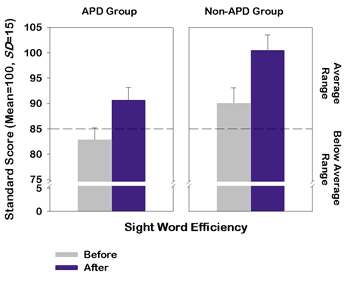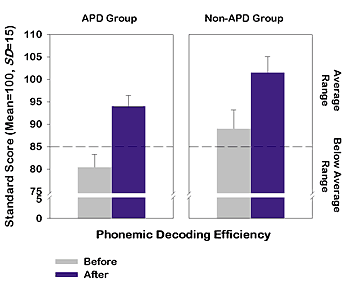Auditory Processing Disorder
Two groups of students from a public primary school in Singapore used the Fast ForWord Language program. The students in both groups were poor readers, but the students in one group also had auditory processing disorders (APD).
Before Fast ForWord participation, the APD group was performing in the below average range in both sight word reading ability and phonemic decoding ability, while the non-APD group was at the low end of the average range in both skills.
After using Fast ForWord Language, both groups demonstrated significant gains in both skill areas, with the APD group moving into the average range in sight word reading ability and phonemic decoding ability.
Before Fast ForWord participation, the APD group was performing in the below average range in both sight word reading ability and phonemic decoding ability, while the non-APD group was at the low end of the average range in both skills.
After using Fast ForWord Language, both groups demonstrated significant gains in both skill areas, with the APD group moving into the average range in sight word reading ability and phonemic decoding ability.
Improved Reading Fluency
Methodology
Students were evaluated with the Test of Word Reading Efficiency before and after using Fast ForWord Language.
Measures
Test of Word Reading Efficiency (TOWRE), a nationally normed measure of word reading accuracy and fluency. The TOWRE contains two components, independently assessing phonemic decoding and sight word recognition.
The Sight Word Efficiency subtest measures the ability to accurately recognize familiar words as whole units.
The Phonemic Decoding Efficiency subtest measures the ability to 'sound out' nonwords that follow English spelling conventions.
In the United States, the Institute for the Development of Educational Achievement, in accordance with the Reading First legislation, determined that the TOWRE subtests are appropriate outcome assessments for accurately measuring improvement in the reading fluency skills of children in early elementary school.
The Sight Word Efficiency subtest measures the ability to accurately recognize familiar words as whole units.
The Phonemic Decoding Efficiency subtest measures the ability to 'sound out' nonwords that follow English spelling conventions.
In the United States, the Institute for the Development of Educational Achievement, in accordance with the Reading First legislation, determined that the TOWRE subtests are appropriate outcome assessments for accurately measuring improvement in the reading fluency skills of children in early elementary school.
Implementation
Researchers at the University of Western Australia were interested in evaluating whether there would be a differential response to Fast ForWord Language by poor readers depending on whether they also had auditory processing disorders (APD).
The implementation process began with educators receiving preliminary training in a number of areas, including:
The implementation process began with educators receiving preliminary training in a number of areas, including:
- Methods for assessing candidates for participation
- Selection of appropriate standardized language and reading measures for testing and evaluation
- Effective implementation techniques
- Proper administration of the programss and effective methods for monitoring student progress
Source
Ho, Cheryl (2004). An examination of Fast ForWord language intervention for children with poor reading abilities. Unpublished honours thesis, School of Psychology, University of Western Australia. Scientific Learning Corporation (2006). Improved Reading Skills and Behavior in Primary School Students who Used Fast ForWord® Language at a Singapore Public School, MAPS for Learning: Educator Reports, 10(5): 1-6.


